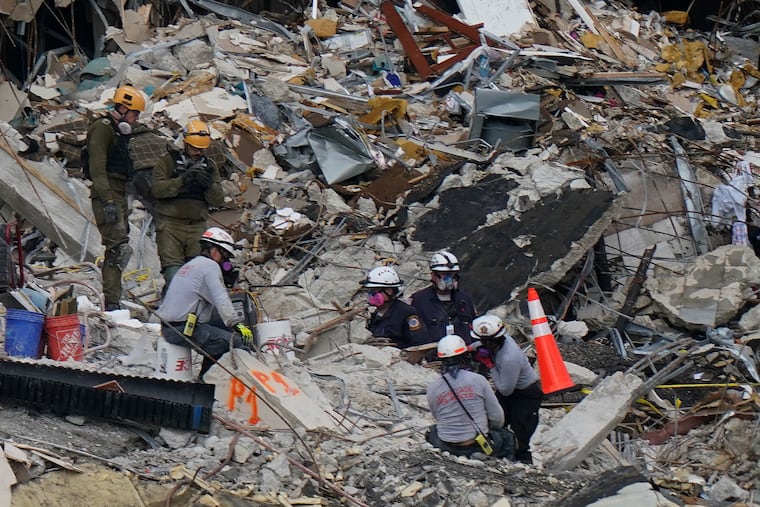Philly lawyer is on scene near the Surfside condominium collapse. How condo owners can protect themselves
A Philadelphia-based lawyer who has handled the region's biggest building collapse cases is in Florida meeting with prospective clients.

Robert Mongeluzzi has been a lead lawyer in the biggest building collapse cases in the Philadelphia region, from the deadly Center City collapse in 2013 to the 2003 Tropicana parking garage collapse in Atlantic City.
He’s now in Florida, at the the scene of the condominium collapse in Surfside, where 18 people were known to have been killed and 145 people were missing as of Wednesday evening. The Philadelphia-based lawyer said he has met with prospective clients who sought him out.
“Given that so many people are missing, it is an incredibly tragic and sad event,” he said. “The not knowing part makes it even worse as the horror and the anxiety lingers for days or weeks. And so that’s very different than the other collapses that we have been involved with.”
The excruciating wait for news is not the only thing that makes this case unique, according to Mongeluzzi, whose Saltz, Mongeluzzi & Bendesky firm has handled roughly 1,000 construction accidents. The death toll could ultimately make it the deadliest building collapse in American history, he said. Video evidence suggests that the fall of the 12-story building may have started from the bottom.
“The fact that a building like this can go down, could fail, and can take [down] literally an entire wing, I think is without precedent,” Mongeluzzi said. “That’s why it’s very difficult to jump to conclusions.”
There’s evidence that engineers and homeowners had warned about the 136-unit building’s flaws. A 2018 inspection of the Champlain Towers South Condo described “major structural damage.” A letter from the president of the building’s condo association — written three months before the catastrophe — said the damage had “gotten significantly worse,” the New York Times has reported.
Still, mixed signals may have led condo owners to believe that the situation wasn’t urgent, according to the Wall Street Journal.
It’s much too early to know who is potentially liable. In Philadelphia, seven people died and 12 were injured in 2013 when a building being demolished collapsed and crushed an adjacent Salvation Army thrift store at 22nd and Market Streets. In the immediate aftermath, one would have believed that the demolition contractor and excavation equipment operator, who were convicted in the case, were solely responsible, Mongeluzzi said. But a jury found that the Salvation Army and New York real estate speculator Richard Basciano were also responsible and were part of the $227 million civil settlement to end the case.
Although the Salvation Army’s thrift store building was destroyed and two of its workers were killed, it was sued for ignoring warnings of an imminent collapse of the adjacent building. The jury found that the charity bore 75% of the responsibility for the harm caused to the shoppers killed and injured in the collapse. It faulted Basciano for not researching the background of the architect and contractor involved in the botched demolition.
In the 2003 garage accident at the Shore, federal investigators found that contractors had failed to install critical steel connections between the casino’s garage decks and an outer wall and had not provided a strong enough support system to brace the concrete decks while the concrete set.
Massive condo repair projects can require relocating residents and convincing owners to pitch in for construction costs, said lawyer Roger Winston, who leads Philly-based Ballard Spahr’s mixed-use, condominium, and multi-family development practice group.
Under case law, condo board members owe a fiduciary duty to unit owners, but that doesn’t mean they are ultimately responsible for everything, Winston said. They may be required to hire qualified property inspectors or pursue a plan for renovations based on those inspections. But a condo may not have enough money for the repairs or unit owners could reject what the board suggests.
“Maybe you fulfilled your fiduciary duty if you make an attempt to do the right thing,” Winston said. “But the unit owners don’t agree to pay the money.”
One option for condo owners stuck in an obsolete building is to terminate the condominium and sell the place to a developer, Winston said. Almost all condos have provisions permitting owners to vote to dissolve the condo, with such votes typically requiring about 80% of owners to be on board. That could allow owners to receive proceeds to pay for a new place somewhere else, rather than spend money on expensive repairs and temporary relocation.
Winston advises people thinking of running for condo boards to be sure they have adequate insurance. Unless board members act recklessly, “you’re going to get defended, your defense costs are going to be covered, and the potential judgment that would be rendered against the board and the board members would be covered,” he said.
Prospective condo owners should research the entire building’s condition before buying — not just their unit — by finding out info from the condo association, the board, or property management company, Winston said.
Mongeluzzi, the construction accident lawyer, advises owners: “See something, say something.”
“If you see something that doesn’t seem right in a building. You see a crack, you see a problem, you hear something. Report it,” he said.